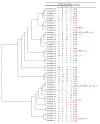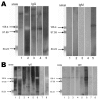Tropheryma whipplei in children with gastroenteritis
- PMID: 20409366
- PMCID: PMC2954008
- DOI: 10.3201/eid1605.091801
Tropheryma whipplei in children with gastroenteritis
Abstract
Tropheryma whipplei, which causes Whipple disease, is found in human feces and may cause gastroenteritis. To show that T. whipplei causes gastroenteritis, PCRs for T. whipplei were conducted with feces from children 2-4 years of age. Western blotting was performed for samples from children with diarrhea who had positive or negative results for T. whipplei. T. whipplei was found in samples from 36 (15%) of 241 children with gastroenteritis and associated with other diarrheal pathogens in 13 (33%) of 36. No positive specimen was detected for controls of the same age (0/47; p = 0.008). Bacterial loads in case-patients were as high as those in patients with Whipple disease and significantly higher than those in adult asymptomatic carriers (p = 0.002). High incidence in patients and evidence of clonal circulation suggests that some cases of gastroenteritis are caused or exacerbated by T. whipplei, which may be co-transmitted with other intestinal pathogens.
Figures


Similar articles
-
Does Tropheryma whipplei contribute to travelers' diarrhea?: A PCR analysis of paired stool samples in French travelers to Senegal.Travel Med Infect Dis. 2014 May-Jun;12(3):264-7. doi: 10.1016/j.tmaid.2014.01.009. Epub 2014 Feb 28. Travel Med Infect Dis. 2014. PMID: 24630594
-
Tropheryma whipplei associated with diarrhoea in young children.Clin Microbiol Infect. 2016 Oct;22(10):869-874. doi: 10.1016/j.cmi.2016.07.005. Epub 2016 Jul 9. Clin Microbiol Infect. 2016. Retraction in: Clin Microbiol Infect. 2024 Sep;30(9):1213. doi: 10.1016/j.cmi.2024.07.001. PMID: 27404363 Retracted.
-
Acute infections caused by Tropheryma whipplei.Future Microbiol. 2017 Mar;12:247-254. doi: 10.2217/fmb-2017-0178. Epub 2017 Feb 27. Future Microbiol. 2017. PMID: 28262041 Review.
-
Prevalence of asymptomatic Tropheryma whipplei carriage among humans and nonhuman primates.J Infect Dis. 2008 Mar 15;197(6):880-7. doi: 10.1086/528693. J Infect Dis. 2008. PMID: 18419351
-
Tropheryma whipplei and Whipple's disease.J Infect. 2014 Aug;69(2):103-12. doi: 10.1016/j.jinf.2014.05.008. Epub 2014 May 28. J Infect. 2014. PMID: 24877762 Review.
Cited by
-
Human gut microbiota: repertoire and variations.Front Cell Infect Microbiol. 2012 Nov 2;2:136. doi: 10.3389/fcimb.2012.00136. eCollection 2012. Front Cell Infect Microbiol. 2012. PMID: 23130351 Free PMC article. Review.
-
Prevalence estimation of Tropheryma whipplei in duodenal biopsy tissues of Koreans.Ann Clin Microbiol Antimicrob. 2024 Jan 3;23(1):2. doi: 10.1186/s12941-023-00658-z. Ann Clin Microbiol Antimicrob. 2024. PMID: 38172885 Free PMC article.
-
Tropheryma whipplei in the stool samples of children with acute diarrhea: a study from Tehran, Iran.BMC Infect Dis. 2022 Feb 27;22(1):193. doi: 10.1186/s12879-022-07198-5. BMC Infect Dis. 2022. PMID: 35220952 Free PMC article.
-
Tropheryma whipplei: a common bacterium in rural Senegal.PLoS Negl Trop Dis. 2011 Dec;5(12):e1403. doi: 10.1371/journal.pntd.0001403. Epub 2011 Dec 20. PLoS Negl Trop Dis. 2011. Retraction in: PLoS Negl Trop Dis. 2025 Jun 26;19(6):e0013229. doi: 10.1371/journal.pntd.0013229. PMID: 22206023 Free PMC article. Retracted.
-
Tropheryma whipplei Detection by Nanopore Sequencing in Patients With Interstitial Lung Disease.Front Microbiol. 2021 Nov 29;12:760696. doi: 10.3389/fmicb.2021.760696. eCollection 2021. Front Microbiol. 2021. PMID: 34912314 Free PMC article.
References
-
- Relman DA, Schmidt TM, MacDermott RP, Falkow S. Identification of the uncultured bacillus of Whipple’s disease. N Engl J Med. 1992;327:293–301. - PubMed
-
- Maiwald M, Ditton HJ, von Herbay A, Rainey FA, Stackebrandt E. Reassessment of the phylogenetic position of the bacterium associated with Whipple’s disease and determination of the 16S–23S ribosomal intergenic spacer sequence. Int J Syst Bacteriol. 1996;46:1078–82. 10.1099/00207713-46-4-1078 - DOI - PubMed
Publication types
MeSH terms
Substances
LinkOut - more resources
Full Text Sources
Medical
